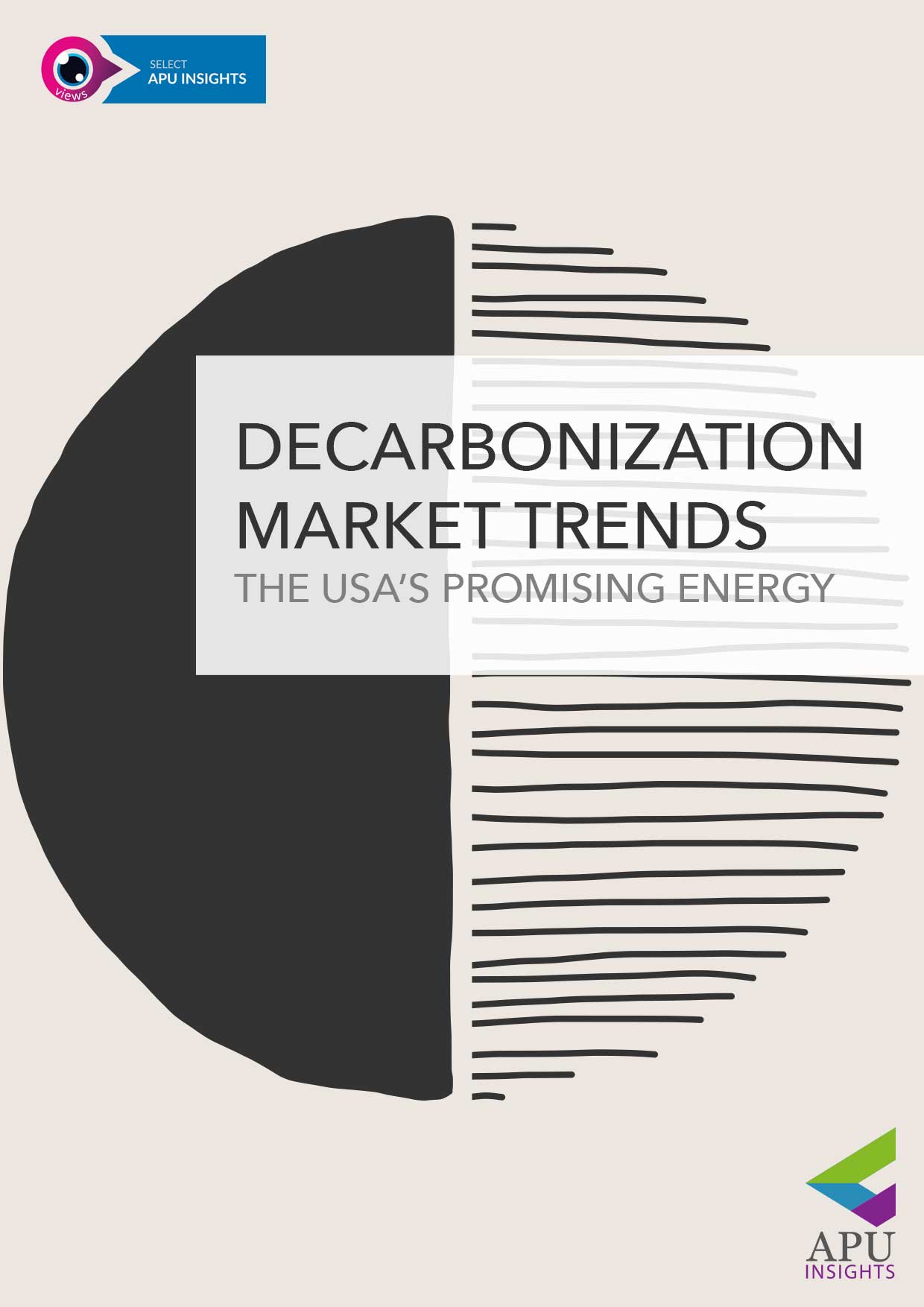Decarbonization market trends: The USA’s promising energy mix
Dr. Evangelo Damigos; PhD | Head of Digital Futures Research Desk
- Competitive Differentiation
Publication | Update: Oct 2021

The global energy mix is shifting from fossil fuels to renewables. There are abundant examples of both public and private organizations working hard to decarbonize the economy. However, many companies are struggling to understand the material impacts that their stated goals are going to have on their valuations, operations, employees and markets over the next few years. From sustainable building materials to green minerals, demand is also increasing for other carbon-neutral products beyond energy. Moreover, climate strikes and marches around the globe have illustrated that both employees and customers mean business when it comes to emission reductions. With large swathes of the public demanding action on climate change, many governments now have a mandate to set carbon reduction targets and enact green legislation. From an energy and resource company perspective, steep reductions in technology costs are helping to enable their decarbonization strategies. Energy storage, which is key to large-scale adoption of renewable energy, is a case in point. Average market prices for battery packs have plunged from US,100/kilowatt hour (kWh) in 2010 to US6/kWh in 2019, an 86% fall in real terms, according to a report released by Bloomberg New Energy Finance (BNEF). advancements in digital technology, such as the Internet of Things (IoT), blockchain, digital twins, and AI-enabled energy-management and trading platforms, also promise to boost efficiency and drive costs down across both conventional and renewable energy value chains.
Thus far, the transition to a low-carbon economy has largely been led by the power and utilities (including renewables) sector. Emissions from leading power and utilities companies around the globe have fallen dramatically since 2015, according to an analysis commissioned by the World Economic Forum. Building on the progress made, some power and utilities companies are raising the bar on their own, without further prompting from regulators. For instance, the Italian multinational energy corporation, Enel, set a carbon-neutral ambition for 2030, well before the 2050 goal of many companies. Companies in the oil, gas and chemicals sectors, whose core business models are based on producing and processing hydrocarbons, have generally been slower to change. Nonetheless, several companies are now seizing upon the transition to a low-carbon economy as a means to transform not only how they operate, but also what they offer. Although the transition to a low-carbon economy is gaining momentum, there is still much work to be done. In a 2019, Monitor Deloitte Australia conducted a market study of 112 companies around the world, 69% of them in the Energy, Resources & Industrials industry. The energy transition also has sector-wide implications for how E&R companies interact with each other as well as for how the sectors themselves may combine and converge. The chemicals sector’s approach to social responsibility is now very much in the spotlight. The scope extends beyond the more traditional forms of chemical industry emissions to carbon, drills down into by-products, and holds operators accountable for post-consumer waste. Global oil and gas markets have been upended. The contraction in global demand caused by the coronavirus pandemic and excess supply from the oil price war between OPEC and other major producers have hit upstream and downstream operations hard. Organizations in the power and utilities space are moving faster to decarbonize than many other sectors. This is due partially to policy but principally to economics. Low-cost natural gas has displaced coal, reducing sector emissions significantly, wind and solar are among the cheapest resources available in most areas, and battery storage costs have plummeted. With a patchwork of different national and local policies to navigate, many mining companies are designing their decarbonization strategies based on the most stringent common denominator and then applying those tactics globally across their organizations. Understanding the financial impact of climate-related risks and opportunities on their businesses is imperative for companies across all sectors. Transition risks include depressed asset values, stranded assets and changing market demand. For example, midstream companies that own gas pipelines may someday encounter decreased utilization or disuse, the odds of which increase with time. An unintended consequence of the transition could be that the big companies will exit the space.
 Digital Themes: Competitive Differentiation
Digital Themes: Competitive Differentiation

HTML
 Access Rights | Content Availability:
Access Rights | Content Availability: 


Objectives and Study Scope
This study has assimilated knowledge and insight from business and subject-matter experts, and from a broad spectrum of market initiatives. Building on this research, the objectives of this market research report is to provide actionable intelligence on opportunities alongside the market size of various segments, as well as fact-based information on key factors influencing the market- growth drivers, industry-specific challenges and other critical issues in terms of detailed analysis and impact.
The report in its entirety provides a comprehensive overview of the current global condition, as well as notable opportunities and challenges.
The analysis reflects market size, latest trends, growth drivers, threats, opportunities, as well as key market segments. The study addresses market dynamics in several geographic segments along with market analysis for the current market environment and future scenario over the forecast period.
The report also segments the market into various categories based on the product, end user, application, type, and region.
The report also studies various growth drivers and restraints impacting the market, plus a comprehensive market and vendor landscape in addition to a SWOT analysis of the key players.
This analysis also examines the competitive landscape within each market. Market factors are assessed by examining barriers to entry and market opportunities. Strategies adopted by key players including recent developments, new product launches, merger and acquisitions, and other insightful updates are provided.
Research Process & Methodology

We leverage extensive primary research, our contact database, knowledge of companies and industry relationships, patent and academic journal searches, and Institutes and University associate links to frame a strong visibility in the markets and technologies we cover.
We draw on available data sources and methods to profile developments. We use computerised data mining methods and analytical techniques, including cluster and regression modelling, to identify patterns from publicly available online information on enterprise web sites.
Historical, qualitative and quantitative information is obtained principally from confidential and proprietary sources, professional network, annual reports, investor relationship presentations, and expert interviews, about key factors, such as recent trends in industry performance and identify factors underlying those trends - drivers, restraints, opportunities, and challenges influencing the growth of the market, for both, the supply and demand sides.
In addition to our own desk research, various secondary sources, such as Hoovers, Dun & Bradstreet, Bloomberg BusinessWeek, Statista, are referred to identify key players in the industry, supply chain and market size, percentage shares, splits, and breakdowns into segments and subsegments with respect to individual growth trends, prospects, and contribution to the total market.
Research Portfolio Sources:
Global Business Reviews, Research Papers, Commentary & Strategy Reports
M&A and Risk Management | Regulation

The future outlook “forecast” is based on a set of statistical methods such as regression analysis, industry specific drivers as well as analyst evaluations, as well as analysis of the trends that influence economic outcomes and business decision making.
The Global Economic Model is covering the political environment, the macroeconomic environment, market opportunities, policy towards free enterprise and competition, policy towards foreign investment, foreign trade and exchange controls, taxes,
financing, the labour market and infrastructure.
We aim update our market forecast to include the latest market developments and trends.
Review of independent forecasts for the main macroeconomic variables by the following organizations provide a holistic overview of the range of alternative opinions:
As a result, the reported forecasts derive from different forecasters and may not represent the view of any one forecaster over the whole of the forecast period. These projections provide an indication of what is, in our view most likely to happen, not what it will definitely happen.
Short- and medium-term forecasts are based on a “demand-side” forecasting framework, under the assumption that supply adjusts to meet demand either directly through changes in output or through the depletion of inventories.
Long-term projections rely on a supply-side framework, in which output is determined by the availability of labour and capital equipment and the growth in productivity.
Long-term growth prospects, are impacted by factors including the workforce capabilities, the openness of the economy to trade, the legal framework, fiscal policy, the degree of government regulation.
Direct contribution to GDP
The method for calculating the direct contribution of an industry to GDP, is to measure its ‘gross value added’ (GVA); that is, to calculate the difference between the industry’s total pretax revenue and its total boughtin costs (costs excluding wages and salaries).
Forecasts of GDP growth: GDP = CN+IN+GS+NEX
GDP growth estimates take into account:

Market Quantification
All relevant markets are quantified utilizing revenue figures for the forecast period. The Compound Annual Growth Rate (CAGR) within each segment is used to measure growth and to extrapolate data when figures are not publicly available.
Revenues
Our market segments reflect major categories and subcategories of the global market, followed by an analysis of statistical data covering national spending and international trade relations and patterns. Market values reflect revenues paid by the final customer / end user to vendors and service providers either directly or through distribution channels, excluding VAT. Local currencies are converted to USD using the yearly average exchange rates of local currencies to the USD for the respective year as provided by the IMF World Economic Outlook Database.
Industry Life Cycle Market Phase
Market phase is determined using factors in the Industry Life Cycle model. The adapted market phase definitions are as follows:

The Global Economic Model
The Global Economic Model brings together macroeconomic and sectoral forecasts for quantifying the key relationships.
The model is a hybrid statistical model that uses macroeconomic variables and inter-industry linkages to forecast sectoral output. The model is used to forecast not just output, but prices, wages, employment and investment. The principal variables driving the industry model are the components of final demand, which directly or indirectly determine the demand facing each industry. However, other macroeconomic assumptions — in particular exchange rates, as well as world commodity prices — also enter into the equation, as well as other industry specific factors that have been or are expected to impact.
Forecasts of GDP growth per capita based on these factors can then be combined with demographic projections to give forecasts for overall GDP growth.
Wherever possible, publicly available data from official sources are used for the latest available year. Qualitative indicators are normalised (on the basis of: Normalised x = (x - Min(x)) / (Max(x) - Min(x)) where Min(x) and Max(x) are, the lowest and highest values for any given indicator respectively) and then aggregated across categories to enable an overall comparison. The normalised value is then transformed into a positive number on a scale of 0 to 100. The weighting assigned to each indicator can be changed to reflect different assumptions about their relative importance.

The principal explanatory variable in each industry’s output equation is the Total Demand variable, encompassing exogenous macroeconomic assumptions, consumer spending and investment, and intermediate demand for goods and services by sectors of the economy for use as inputs in the production of their own goods and services.
Elasticities
Elasticity measures the response of one economic variable to a change in another economic variable, whether the good or service is demanded as an input into a final product or whether it is the final product, and provides insight into the proportional impact of different economic actions and policy decisions.
Demand elasticities measure the change in the quantity demanded of a particular good or service as a result of changes to other economic variables, such as its own price, the price of competing or complementary goods and services, income levels, taxes.
Demand elasticities can be influenced by several factors. Each of these factors, along with the specific characteristics of the product, will interact to determine its overall responsiveness of demand to changes in prices and incomes.
The individual characteristics of a good or service will have an impact, but there are also a number of general factors that will typically affect the sensitivity of demand, such as the availability of substitutes, whereby the elasticity is typically higher the greater the number of available substitutes, as consumers can easily switch between different products.
The degree of necessity. Luxury products and habit forming ones, typically have a higher elasticity.
Proportion of the budget consumed by the item. Products that consume a large portion of the
consumer’s budget tend to have greater elasticity.
Elasticities tend to be greater over the long run because consumers have more time to adjust their behaviour.
Finally, if the product or service is an input into a final product then the price elasticity will depend on the price elasticity of the final product, its cost share in the production costs, and the availability of substitutes for that good or service.
Prices
Prices are also forecast using an input-output framework. Input costs have two components; labour costs are driven by wages, while intermediate costs are computed as an input-output weighted aggregate of input sectors’ prices. Employment is a function of output and real sectoral wages, that are forecast as a function of whole economy growth in wages. Investment is forecast as a function of output and aggregate level business investment.




 Industry: Energy and Natural Resources
Industry: Energy and Natural Resources 
